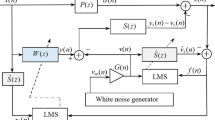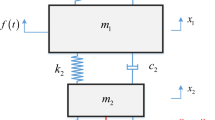Abstract
In the previously introduced direct adaptive command shaping filter (ACSF), the time-delay value is fixed and only the magnitudes of the impulses are learned. The performance of the direct adaptive time-delay command shaping filter, however, depends on the select time-delay. In this paper, the authors introduce a new scheme to extract the optimal time-delay value for the improved vibration suppression in flexible motion system. To develop the optimal time-delay extraction scheme, the authors have analyzed the effect of the time-delay value on the performance of the direct ACSF. Based on the analysis result the authors have established a set of equations to extract the optimal time-delay toward the optimal vibration suppression performance of ACSF. Experimental results using a gantry robot with a single flexible link show the effectiveness of the proposed time-delay adaptation approach for the improved vibration suppression.
Similar content being viewed by others
References
N.C. Singer, W. Singhose, and W. Seering, Comparison of filtering methods for reducing residual vibrations, European J. of Control, 5 (1999) 211–218.
A. Tzes and S. Yurkovich, An adaptive input shaping control scheme for vibration suppression in slewing flexible structure, IEEE Trans. on Control System Technology, 1 (1993) 114–121.
M. Bodson, An adaptive algorithm for the tuning of two input shaping methods, Automatica, 34 (1998) 771–776.
S. Rhim and W.J. Book, Vibration suppression of a flexible manipulator using adaptive time-delay command shaping filter, IEEE/ASME Trans on Mechatronics, 9 (2004) 619–626.
S. Rhim and W.J. Book, Noise effect on timedomain adaptive command shaping methods for flexible manipulator control, IEEE Trans on Control System Technology, 6 (2001) 84–92.
J. Park and S. Rhim, Extraction of Optimal Timedelay in Adaptive Command Shaping Filter for Flexible Manipulator Control, J. of Inst. of Control, Robotics and Sys, 14(6) (2008) 564–572.
Author information
Authors and Affiliations
Corresponding author
Additional information
Joo Han Park received the B.S. and M.S. degrees in Mechanical Engineering from the Kyung Hee University, Korea, in 2005 and 2007. He is currently a candidate for the PhD at Kyung Hee University, Korea. His research interests include robotics and vibration control.
Sungsoo Rhim received his B.S. and M.S. degrees in Mechanical Engineering from Seoul National Univ., Korea, in 1990 and 1992 respectively. He then received his Ph.D. degree from Georgia Institute of Technology in 2000. He worked for CAMotion, Inc. in GA, USA, as Research Director from 2000 until 2003 and he is currently an Assistant Professor at the Dept. of Mechanical Engineering in Kyung Hee Univ., Korea. His research interests include system dynamics, control, robotics and vibration.
Rights and permissions
About this article
Cite this article
Park, JH., Rhim, S. Experiments of optimal delay extraction algorithm using adaptive time-delay filter for improved vibration suppression. J Mech Sci Technol 23, 997–1000 (2009). https://doi.org/10.1007/s12206-009-0328-1
Received:
Revised:
Accepted:
Published:
Issue Date:
DOI: https://doi.org/10.1007/s12206-009-0328-1




